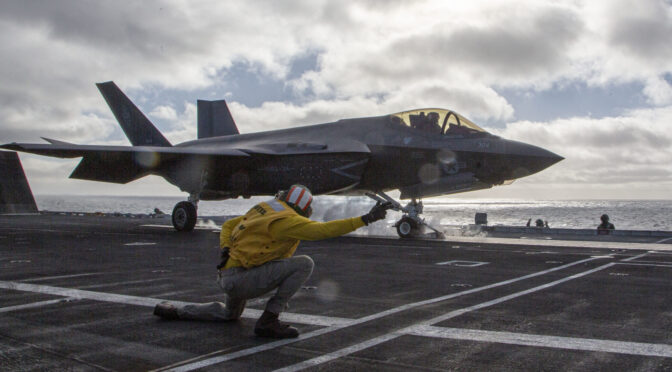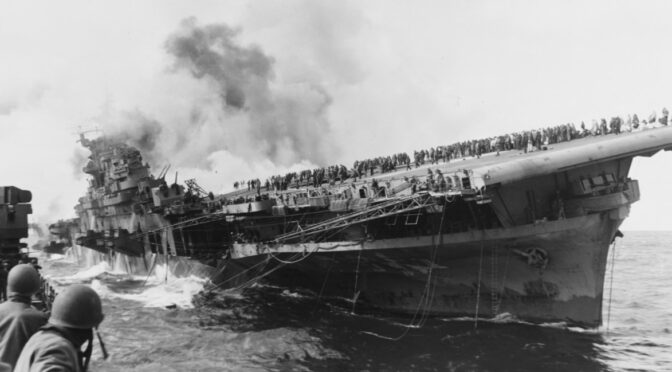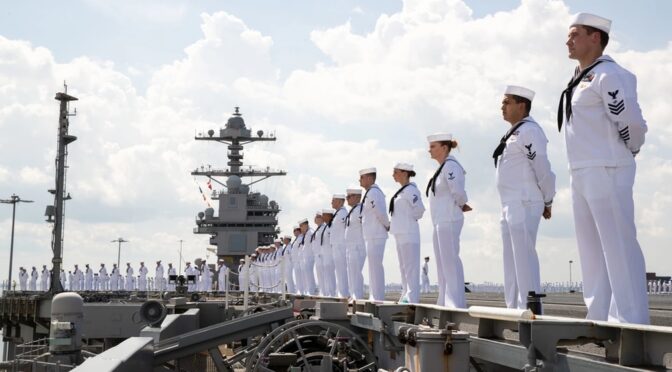By Brent D. Sadler
Introduction
On September 18, the Chief of Naval Operations (CNO) Adm. Lisa Franchetti released her Navigation Plan (NAVPLAN) laying out the course ahead for the Navy. The main takeaway is that the Navy must be ready to deter a militarily confident China by 2027. Achieving this is a tall order. NAVPLANs have been used by senior naval officers to provide guidance and caution against potential pitfalls along a course. CNO Admiral Jonathan Greenert began using these documents in 2015 to inform the path to rebuilding the Navy. In recent years, the Navy’s NAVPLANs have taken on urgency to deter a rapidly expanding Chinese fleet.
That said, these plans have been ineffective for the better part of 10 years. The fleet has only grown from 271 warships in 2015 to today’s fleet of 295. This happens at a time the Navy, White House, and Congress have all committed to a fleet of 355 warships. But it took several years to even get a plan that could achieve that goal and by now should have delivered a fleet of 314 warships. Instead, the Navy is 19 ships behind.
Meanwhile the Chinese Communist Party has grown its Navy – the PLAN – by over 112 warships between 2004 to 2022, while the U.S. Navy’s size shrunk by three ships. Buoying the PLAN’s meteoric rise is a massive, modern commercial shipbuilding industry that is over 200 times the capacity of the U.S., giving China the ability to out-produce the U.S. fleet in a prolonged war. The challenge of growing the fleet is also hampered by inadequate munitions production and capability. In short, getting the Navy on course will require more than just building new warships.
Setting a Course
Given these challenges, in the NAVPLAN CNO Franchetti makes a clear preference for action focused on readiness by 2027. This framing provides needed urgency and focus to ensure a large organization of over half-million officers, sailors, reservists, and civilians act in concert with limited resources.
With limited warships and munitions, creative new ways of waging naval war are required. Enter the Navy’s almost decade-old concept – Distributed Maritime Operations. By dispersing the fleet across a wider area, China would have to deploy more sensors, platforms, and weapons to degrade the U.S. Navy. This concept assumes a high degree of connectivity across U.S. warships, submarines, and aircraft to work. Rightly, the new NAVPLAN embraces this concept and focuses effort on maturing critical enabling capabilities, including autonomous systems, big data analytics, and the maritime operating centers to fuse multiple data streams into actionable information for commanding officers at sea.
The rationale for CNO Franchetti’s update to the last NAVPLAN issued in 2022 by her predecessor is the more dangerous security environment today. To address this, and the most interesting aspect of the NAVPLAN, is Project 33. This refers to her core objectives as the 33rd Chief of Naval operations, and encompasses seven key targets:
1. Readiness – By 2027, achieve and sustain an 80 percent combat surge-ready fleet.
2. Robotics – By 2027, integrate mature autonomous platforms into every deploying carrier strike group and expeditionary strike group.
3. Warfighting Headquarters – By 2027, all numbered fleets will have fully functioning Maritime Operation Centers (MOC) to coordinate naval operations across the globe.
4. Manning – By 2027, achieve 100 percent active and reserve components manning, with 95 percent of authorized deployed billets filled.
5. Improved Quality of Life – By 2027, eliminate involuntary billeting onboard ship while in homeport, which is critical for sailors stuck in shipyards for prolonged maintenance with unsatisfactory onboard living conditions.
6. Better Fleet Training – By 2027, implement more realistic wartime exercising of the fleet for high-end warfare, especially through Live Virtual Constructive training (LVC).
7. Infrastructure – By 2027, act to address the Navy’s antiquated infrastructure and shipyard capacity to sustain the fleet.
Admiral Franchetti’s emphasis on 2027 is welcome given China has invested significant resources and political capital on being ready to persevere in a war with the U.S. by that year. Making a down payment alone on Project 33 will require growing the Navy’s budget three to five percent above inflation. Fully addressing the needs of the Navy will likely be a taller order.
Aside from specifics to remedy outdated shipyards unable to sustain today’s Navy, another issue not raised was the need to fuel the fleet. Since before World War II, the U.S. military had stockpiled fuel at the strategically important Red Hill Bulk Fuel Storage facility in Hawaii. Due to years of neglect, that facility has been shut down, and no replacements have yet to been announced. Without adequate fuel reserves and the ability to move fuel to the ships and aircraft using it, the Navy is in a potentially precarious position. The DMO concept also depends on a robust logistical foundation that could outstrip the Navy’s current capabilities. Distributed logistics and robust fuel access are not effectively described in the NAVPLAN, an oversight that will need to be addressed in the near future by the CNO.
Without adequate manning and infrastructure the fleet will not grow to meet the threat nor can it be sustained. On this point the NAVPLAN’s details are too thin. It has been clear for many years that the Navy needs more shipyard capacity to build new warships and repair them. Yet no call for returning public shipyards to do nuclear maintenance on submarines nor calling for the building of new drydocks is mentioned. There is a political dimension to this of course, which is why leadership is required to get the Navy these needed resources from Congress.
Where the NAVPLAN is scant on details, it must not necessarily mean inaction. Seeking a new public shipyard is a herculean political and fiscal task, and would be a first since World War II. Congress in recent years has been willing to support larger budgets for getting the Navy needed resources, but the Department of Defense has been less willing. As such, leadership is required to propose a plan for a new public shipyard, which is well past due.
Another point that is caught between the bullet points of Project 33 is practicing for the next war. Standing up a maritime operations center (MOC) at each numbered fleet is past due, as is fully leveraging real-world exercises with virtual environments to most closely approximate wartime conditions. Yet to be truly ready, the fleet needs to be exercised in the harshest environment and threat conditions to persevere against a foe like China. Missing in the NAVPLAN is the value and urgency for exercising at the fleet-level to challenge planning assumptions, test systems performance, and validate crew competencies. With Congressional support, the Navy should evolve the current Fleet Battle Problem series of exercises into events similar in scale and design to the Fleet Problem series of exercises of the interwar period to prepare for modern naval warfare.
Finally, new approaches to recruiting and preparing sailors for the rigors at sea are urgently needed. Diversity, Equity and Inclusion was ostensibly intended to expand recruitment, but the record is far less than positive. That said, the Navy and the nation needs every physically able, patriotic citizen who seeks a life at sea to succeed. This means investing more in wider recruitment while not alienating traditional sources of recruits.
Getting the sailors the Navy needs means investing more in new recruits as well. This will of course add to the Navy’s budget and delay entry of these new sailors to the fleet. The Navy must accept that not everyone starts at the same point, but those giving their all are needed in these dangerous times. As such, more is needed to ensure new recruits are kept and brought up to meet and exceed technical training requirements. For this reason, programs like BOOST that were ended in 2008 need to be brought back and given an update. BOOST was intended to give promising enlisted sailors from disadvantaged education systems preparation for college and officer commissions. Today this is needed for able-bodied and driven recruits to prepare for not only commissions, but for highly technical specialties in short supply, like nuclear mechanics.
Conclusion
Admiral Franchetti clearly takes inspiration from her predecessor, Admiral Elmo Zumwalt, who was CNO from 1970 to 1974, during a tumultuous period for the Navy. As she more forcefully pushes the rudder over on a new course for the Navy, another Admiral’s words come to mind, Admiral William J. Crowe, “The CNO . . . can turn the helm, but the rudder doesn’t necessarily go with it, because there are a bunch of people down in the bowels pushing it the other way.”
A strategy or checklist will not deliver results alone. Bold leadership is called for, from the deckplate to the CNO. Admiral Franchetti’s NAVPLAN is welcome and needed, but its success will not be decided by how convincing the document is. She will need the support of forceful leaders throughout the organization who are driven by the vision of what is required, and who are held accountable beyond the limited tenure of their current assignments.
The consequences of further delays and procrastination only benefits the designs of rivals. The CNO has stated she intends to act vigorously and provide a stronger Navy for her successor. Hopefully there are more such leaders in the ranks with the backing required to finally bend the too-long downward trajectory of the Navy and get it on track for facing down today’s great power threats.
Captain Brent Sadler (Ret.) joined the Heritage Foundation as a Senior Research Fellow in 2020 after a 26-year naval career in nuclear submarines and as a foreign area officer. He has extensive operational experience in the Western Pacific, having served at Seventh Fleet, Indo-Pacific Command, as Defense Attache in Malaysia, and as an Olmsted Scholar in Tokyo, Japan.
Featured Image: Marine Fighter Attack Squadron (VMFA) 314 launch and recover F-35C as they work to renew their carrier qualifications onboard the USS Abraham Lincoln (CVN 72). (U.S. Marine Corps photo by 1stLt. Charles Allen/Released)




